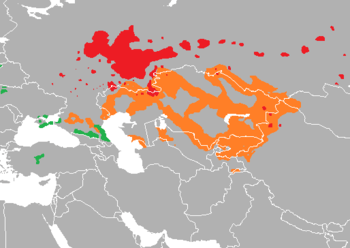Kipchak languages
The Kipchak languages (also known as the Kypchak, Qypchaq or the Northwestern Turkic languages) are a sub-branch of the Turkic language family spoken by approximately 31.3 million people in much of Central Asia and Eastern Europe, spanning from Ukraine to China. Some of the most widely spoken languages in this group are Kazakh, Kyrgyz and Tatar.
| Kipchak | |
|---|---|
| Northwestern Turkic | |
| Ethnicity | Kipchaks |
| Geographic distribution | Central Asia, Russia, Northern Caucasus, Ukraine |
| Linguistic classification | Turkic
|
| Subdivisions |
|
| Glottolog | kipc1239[1] |
 Kipchak–Bulgar
Kipchak–Cuman
Kipchak–Nogai and Kyrgyz–Kipchak | |
Kipchak languages by native speakers
The Turkic languages are a language family of at least 35 [2] documented languages, spoken by the Turkic peoples. The number of speakers derived from statistics or estimates (2019) and were rounded:[3][4]
| Number | Name | Status | Native speakers | Main Country |
|---|---|---|---|---|
| 1 | Kazakh language | Normal | 14,000,000 | |
| 2 | Tatar language | Normal | 5,500,000 | |
| 3 | Kyrgyz language | Normal | 5,000,000 | |
| 4 | Bashkir language | Vulnerable | 1,500,000 | |
| 5 | Karakalpak language | Normal | 650,000 | |
| 6 | Crimean Tatar language | Severely endangered | 600,000 | |
| 7 | Kumyk language | Vulnerable | 450,000 | |
| 8 | Karachay-Balkar language | Vulnerable | 400,000 | |
| 9 | Siberian Tatar language | Definitely endangered | 100,000 | |
| 10 | Nogai language | Definitely endangered | 100,000 | |
| 11 | Krymchak language | Critically endangered | 200 | |
| 12 | Karaim language | Critically endangered | 100 | |
| Total | Kipchak languages | Normal | 31,300,000 |
Linguistic features
The Kipchak languages share a number of features that have led linguists to classify them together. Some of these features are shared with other Common Turkic languages; others are unique to the Kipchak family.
Shared features
- Change of Proto-Turkic *d to /j/ (e.g. *hadaq > ajaq "foot")
- Loss of initial *h (preserved only in Khalaj), see above example
Unique features
- Extensive labial vowel harmony (e.g. olor vs. olar "them")
- Frequent fortition (in the form of assibilation) of initial */j/ (e.g. *jetti > ʒetti "seven")
- Diphthongs from syllable-final */ɡ/ and */b/ (e.g. *taɡ > taw "mountain", *sub > suw "water")
Classification
The Kipchak languages may be broken down into four groups, based on geography and shared features:[1] Languages in bold are still spoken today.
| Proto-Turkic | Common Turkic | Kipchak | Kipchak–Bulgar (Uralian, Uralo-Caspian) | |
| Kipchak–Cuman (Ponto-Caspian) | ||||
| Kipchak–Nogai (Aralo-Caspian) | ||||
| Kyrgyz–Kipchak (Kyrgyz) | ||||
| South Kipchak |
*Note: Kipchak–Cuman base, but have been heavily influenced by Oghuz languages.
See also
- Kipchak language
- Kipchaks
- Kipchaks in Georgia
- Cuman people
- Cuman language
- Cumania
- Kalpak
References
- Hammarström, Harald; Forkel, Robert; Haspelmath, Martin, eds. (2017). "Kipchak". Glottolog 3.0. Jena, Germany: Max Planck Institute for the Science of Human History.
- Dybo A.V., Chronology of Türkic languages and linguistic contacts of early Türks, Moscow, 2007, p. 766, "Archived copy" (PDF). Archived from the original (PDF) on 2005-03-11. Retrieved 2005-03-11.CS1 maint: archived copy as title (link) (In Russian)
- https://www.ethnologue.com/
- https://glottolog.org/
Bibliography
- Johanson, Lars; Csató, Éva Ágnes (1998). The Turkic Languages. London: Routledge. ISBN 0-415-08200-5.
- Menges, Karl H. (1995). The Turkic Languages and Peoples (2nd ed.). Wiesbaden: Harrassowitz. ISBN 3-447-03533-1.